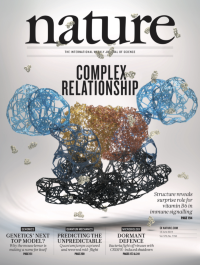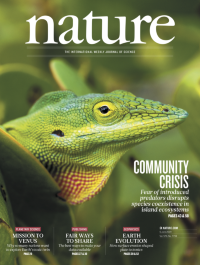Volume 570
-
No. 7762 27 June 2019
Flying soloFlying an object heavier than air is energetically expensive no matter what the size, but this challenge is exacerbated at very small scales because of the need to integrate lightweight components to provide the necessary electronics and propulsion. This means that most insect-size vehicles fly tethered to an off-board power supply. In this week’s issue, Noah Jafferis, Farrell Helbling and their colleagues introduce RoboBee X-Wing, an aerial vehicle the size of an insect that is capable of untethered flight. Weighing just 90 milligrams, RoboBee X-Wing has four wings driven by two piezoelectric actuators and carries a 60-mg photovoltaic array and a 91-mg signal generator, giving it a thrust efficiency matching that of similarly sized insects.
-
No. 7761 20 June 2019
Freedom of movementIn this week’s issue, Ichiro Takeuchi and his colleagues present evidence for the perfect transmission of electrons through a contact barrier between a normal metal and a topological superconductor. The work represents the observation of Klein tunnelling, a relativistic effect in which a particle can move through a barrier between two materials as if the barrier simply wasn’t there. Once an electron (gold sphere) has tunnelled through the barrier, it picks up a partner electron to form a Cooper pair (seen in the cover image at the far side of the tunnel). As a result, a negatively charged hole (black sphere) is reflected back from the barrier. Generally, there is some scattering of electrons at the barrier suppressing this process. But at the barrier with a topological superconductor, electron scattering is completely forbidden. Perfect electron tunnelling and the hole reflection therefore lead to exact doubling of the conductance, which the team’s results confirm. The researchers found that perfect transmission occurred regardless of the origin of the contact barrier and suggest that the finding could be useful in quantum information processing.
Nature Index
-
No. 7760 13 June 2019
Complex relationshipIn its active form, the enzyme serine hydroxymethyltransferase 2 (SHMT2) plays an important role in metabolism through its ability to synthesize building blocks that are essential for cell growth and proliferation. The SHMT2 enzyme is activated by its cofactor PLP, the active form of vitamin B6. In its inactive form, SHMT2 is also known to regulate immune signalling through its interaction with the BRISC deubiquitylase complex. In this week’s issue, Elton Zeqiraj, Roger Greenberg and their colleagues present the structure of the human BRISC–SHMT2 complex and reveal an unexpected role for vitamin B6 in controlling complex assembly and function in immune signalling. The structure of the complex was generated at a resolution of 3.8 ångströms using cryo-electron microscopy.BRISC forms a U-shaped structure with a base (black) and two arms (blue). SHMT2 (orange) bridges the two arms and blocks the BRISC active site, inhibiting its enzyme activity until it reaches its specific target. The researchers show that metabolite activation of SHMT2 by PLP (shown as randomly scattered flakes) hampers it from forming a complex with BRISC. The team notes that increased intracellular levels of PLP reduced BRISC–SHMT2 interactions and inflammatory signalling, revealing a direct link between vitamin B6 metabolism and the control of an immune response.
-
No. 7759 6 June 2019
Community crisisThe way in which the introduction of predators into island ecosystems affects other species is investigated by Robert Pringle and his team in this week’s issue. The researchers looked at 16 Bahamian islands, where the top native predator was the semi-terrestrial brown anole lizard (Anolis sagrei). To some islands, the researchers introduced combinations of the tree-dwelling green anole (Anolis smaragdinus) and, as a predator of both anole species, the ground-dwelling curly-tailed lizard (Leiocephalus carinatus). The team then followed changes to population size, habitat use and diet for the three species over the course of six years. On islands lacking the curly-tailed lizard, the two species of anole coexisted, occupying separate dietary and habitat niches. But on the four islands where L. carinatus was also introduced, fear of predation pushed the brown anoles to seek safety in the trees, where they competed with green anoles for resources, driving the latter extinct on two of the islands. The researchers note that this example of ‘refuge competition’ shows that top predators do not necessarily promote increased biodiversity, and that the risk of predation can destabilize species coexistence.




